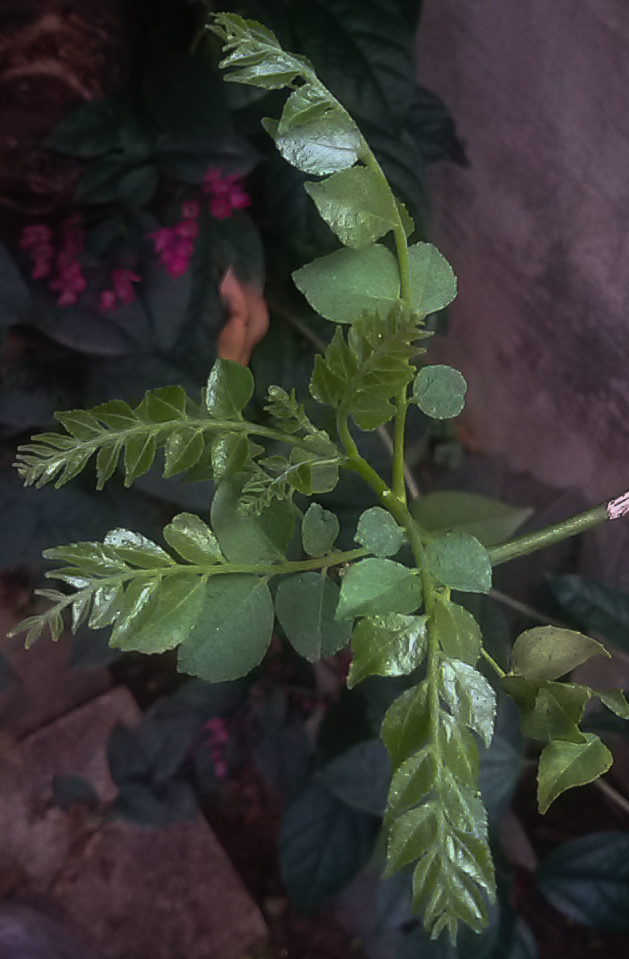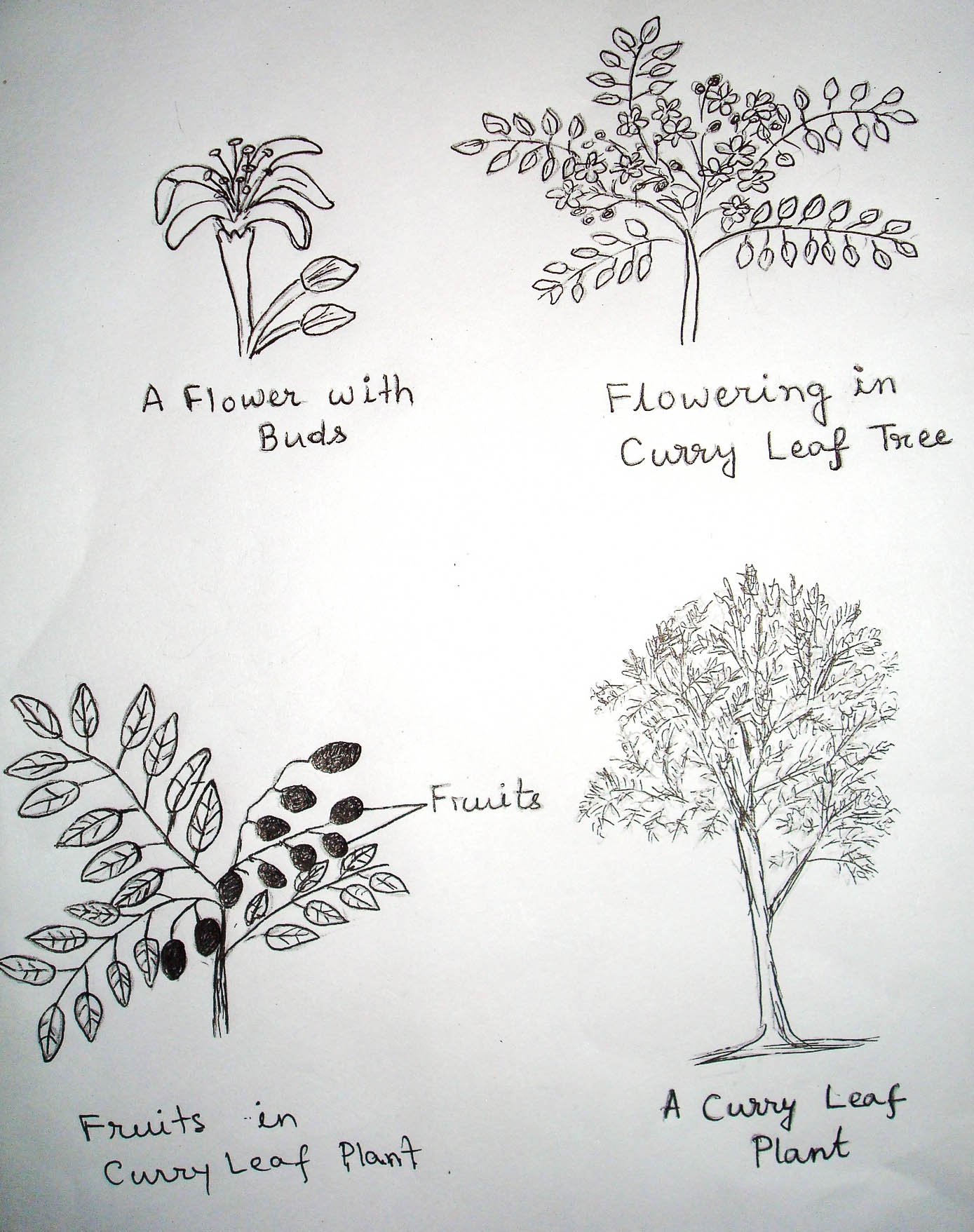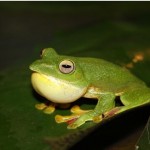Curry Leaf : A Gem Of Indian Cooking
Dr. Rashmi Rekha Patra
Curry leaf is synonymous with hot and mouth watering South Indian cuisine. Once it is added to a curry, it gives a distinct aroma. Today this wonderful flavoured leaf is widely used in various parts of India not only for amazing taste and smell it brings to the dishes, but also for the wonderful health benefits it offers, externally and internally as well as for its easy availability. Curry leaf or kadi patta’s esssence is so refreshing that it instantly tantalizes the taste buds. This plant is quite ornamental due to its compound leaves. It is sometimes used as a hedge and an ornamental plant.

Curry Leaves
NAME
The scientific name of curry leaf is Murrya koenigii (L.) Spreng and it belongs to the family Rutaceae. Curry leaves resemble the leaves of `neem’ or Indian Lilac, hence it is called “sweet neem” or “kadi patta” in Hindi, surabhinimba, kalasaka, mahanimb in Sanskrit, bhrusanga patra in Odia, Karepaku in Telugu, barsanga, kartaphuli in Bengali, karivempu or karuveppilei in Tamil. The scientific name of curry leaf Murraya koenigii, is derived from the names of two botanists of 18th century, the Swedish Johann Andreas Murray (1740-91) and the German Johann Gerhard Konig (1728-85).
ORIGIN
Murrya Koenigii (L.) Spreng is native to India and Sri Lanka. It is commonly found in the outer Himalayas, from Ravi eastwards ascending to 5,000 ft. in Assam, Bangladesh and Myanmar. In the evergreen and deciduous forests of peninsular India, curry leaf plant is often found as underwood (Brandis, 1906). It is cultivated in various other countries such as China, Australia, Nigeria and Sri Lanka.
SCIENTIFIC CLASSIFICATION
Kingdom : Plantae – Plants
Subkingdom : Tracheobionta – Vascular plants
Superdivision : Spermatophyta – Seed plants
Division : Magnoliophyta – Flowering plants
Classification : Dicotyledons
Subclass : Rosidae
Order : Sapindales
Family : Rutaceae – Rue family
Genus : Murraya J. Koenig ex L. –Murraya
Species : Koenigii (L.) Spreng.- Koenigii.
GENERAL DESCRIPTION
The curry leaf tree is a shrub or tree that grows up to 13 to 20 feet in height. The main stem is dark green to brownish with numerous dots on it. The foliage is the real standout. Leaves are bipinnately compound, about 30-35 cm long, each bearing around 21-24 leaflets, having reticulate venation; 5 cm. long, broad lanceolate leaflets with 1cm long petiole. Each flower is a white, funnel shaped, stalked, sweetly scented. Around 60-90 flowers are borne in a terminal cymose inflorescence. These flowers can self pollinate to produce small shiny black berries containing a large viable spinach green seed. Neither the berry pulp nor the seed is used for culinary purposes (Henry and Trimen, 1893).
PROPAGATION
Growing curry leaf tree from seeds is not an easy job. But it can be grown from stem cuttings. Take a 5 inch piece long stem from the curry leaf tree that has several leaves. Remove the bottom 1 inch of leaves. Immerse the bare stem into the soil and moist thoroughly. It will root in about three weeks if kept in warm and moist condition. Growing curry leaf plant indoors in a well drained pot with good potting mix and keeping it in a sunny area is a healthy option. Feed it regularly with a dilute solution of seaweed fertilizer and trim the leaves periodically to make it bushy and small in size. Curry leaf plant starts flowering from the middle of April and ends in the middle of May. The fruiting season continues from middle of July to the end of August.
NUTRITIONAL VALUE OF CURRY LEAVES
The nutritional value of curry leaves show 66.3% moisture content as well as 6.1% protein, nearly zero fat (0.1g per 100g leaves) and other carbohydrates present in addition to the 6.45 % fibre content. Curry leaves are also highly valued for the fact that they have high quantities of iron, phosphorous, vitamin A, vitamin B, vitamin C, nicotinic acids, antioxidants, amino acids, glycosides and flavonoids. Some of the other chemical constituents present in curry leaves include carbazole alkaloids. Research studies by the department of Home economics of Kenmei Women’s Junior College in Hyogo, Japan showed that alkaloids found in curry leaves posses antioxidant properties. An alkaloid, murrayacinine, is also found in the leaves (Chakrabarty et al., 1974). Curry leaves are the best when used fresh, they have a short life span and hence they should be stored in a refrigerator for future use. However, make sure that you do not take them off the refrigerator for a long time, as this will make them lose their flavour.
HEALTH BENEFITS OF CURRY LEAVES
Most of us remove the curry leaf from the curry without knowing its health benefits, some of which are as follows:
Cures Diarrhoea: Studies revealed that the carbazole alkaloid present in the curry leaves has anti-diarrhoea properties. The paste of curry leaves or its juice can be effective for this purpose (Harish Pagariya and Maithili, V. 2014).
Antioxidant properties: Leaves of Murraya koenigii have antioxidant properties (Mylarappa B. and Ningappa, 2008). The presence of various vitamins like vitamin A, B, C and E help in reducing oxidative stress and free radical scavenging activity.
Cures Indigestion: Curry leaves are effective in indigestion. The juice of curry leaves and lime juice can be consumed together for indigestion or a paste made from the leaves can be added to buttermilk and taken every morning in an empty stomach.
Curry Leaves for Diabetes: One of the biggest health benefits of curry leaves is that regular consumption of it has proven to lower blood sugar levels. M. koenigii treatment exerts a therapeutic protective nature in diabetes by decreasing oxidative stress and pancreatic β-cell damage in rats (Palanisamy A. and Subramanian, S.P., 2007).
Curry Leaves for Anemia: Being rich in iron, curry leaf is easily absorbed by the body, approximately 100 gm of curry leaves contain around 0.930 mg of iron. So daily intake of a handful of curry leaves along with a tsp of methi seeds in little bit of fresh yogurt after keeping for ½ an hour early in the morning is a good relief from anemia.
Lowers Cholesterol levels: Curry leaves are known to reduce bad cholesterol level. Studies conducted at the Department of Biochemistry, University of Kerala, India have shown that curry leaves have the potential to reduce LDL cholesterol levels.
Protective against Pathogen attacks: Chemical examination of the strong odiferous oil present in the leaves and seeds of Murraya koenigii (L.) Spreng by Nigam and Purohit (1961) and Goutam and Purohit (1974) reported that this essential oil exhibited a strong antibacterial and antifungal activity.
Helps during Pregnancy: Morning sickness, vomiting tendency etc. are some of the discomforts faced by many pregnant women. If one can consume the water that has boiled curry leaves, it will reduce morning discomfort and nausea.
Cytotoxic activity: Carbazole alkaloids from the stem of the curry leaf plant are said to inhibit the growth of human leukemia cell lines. They are said to be active against leukemia and colon cancer cell lines. This plant has also significant anti-tumor activity.
Protects the Liver: Research on curry leaves has shown that the tannins and carbazole alkaloids present in them exhibited good hepato-protective properties. They are also helpful in protecting the liver from hepatitis and cirrhosis.
Good for Eyesight: Deficiency of vitamin A may cause night blindness, cloud formations in front of the eye and even the loss of vision in some cases. Vitamin A present in curry leaves contains carotenoids which protect the cornea of the eye.
Good for Hair: Vitamin B6 (pyridoxine) present in curry leaves act as the hormone regulators for preventing hair loss. With high nutritional value, curry leaves strengthen hair shaft and hair roots. Curry leaves constitute a combination of essential nutrients required for the growth of hair. They are rich in antioxidants and amino acids which help to reduce hair fall, stimulate hair growth and strengthen the hair follicles. Curry leaves are also a rich source of beta-carotene and proteins. Beta carotene limits hair loss while presence of proteins prevents hair thinning.
How to use it for hair : A hair mask made by mixing a handful each of curry leaves and neem leaves along with 2-3 tsp of yogurt restores damaged hair and makes it smooth, shiny and healthy. One can make a hair oil by mixing sundried and powdered curry leaves in coconut oil and boiling it for 2-3 minutes. Then strain it and massage this oil on the scalp and hair to get rid of prematurely graying of hair. The growth of new hair strands also makes it to fight against alopecia.
It can thus be concluded that due to its great health benefits and for adding taste and flavour to the dish, the curry leaf plant is truly the `Gem of Indian Cooking’. We should make a habit to include it in our diet and encourage the children to eat it along with the curry in order to remain healthy and fit throughout their life.
Dr. Rashmi Rekha Patra
M.Sc., M.Phil, PhD (Botany)
Qr. No. 62, Type-IV, IVRI Campus,
Izatnagar-243122, Bareilly, Uttar Pradesh
E-mail: rashmirekharrp@gmail.com
- Peace Lily : An efficient air purifier - 27 June,2020
- Curry Leaf : A Gem Of Indian Cooking - 27 June,2016
- A Primer on Noise Pollution - 25 October,2015












My better half, who is perennially on the lookout for curry leaves during the course of her morning walks, will almost immediately strike a chord with Dr Patra. I had always suspected this herb to have tons of medicinal qualities, but the the long list here took me by surprise —it covers nearly all of the maladies I suffer from, except the streak of madness that makes me write blogs even though I know it is no good.
Great info Dr. Patra, Thank you!
Thank you Sabya, for this precious piece:)
So many benefits in one plant…we have one in our little window garden and it has been very gracious in producing beautiful leaves and flowers for us.
My love for the plant made me read this.